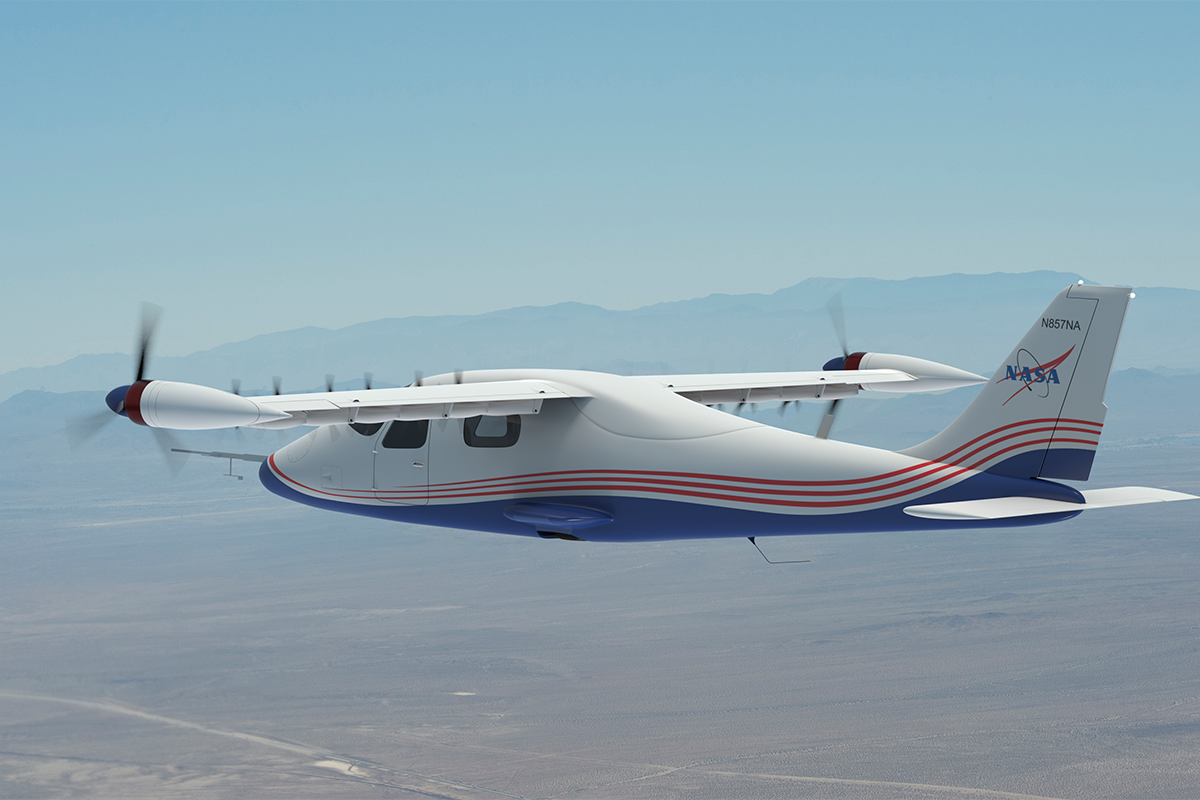NASA X-57 First Flight on Track for September
Engineers working on NASA’s X-57 Maxwell are closing in on the all-electric experimental airplane’s first flight test, expected as early as September 20.

An artist rendering of the final iteration of the all-electric X-57 Maxwell in flight. [Courtesy: NASA]
The development team working on NASA’s X-57 Maxwell are closing in on the all-electric experimental airplane’s first flight test, which the agency said could take place as soon as September 20, if all goes as planned.
This initial flight will make the aircraft—named for the 19th century Scottish scientist James Clerk Maxwell—NASA’s first piloted X-plane in two decades.
The X-57 is basically a Tecnam P2006T twin with four seats, which has been modified to accommodate an integrated electric propulsion system powered by lithium-ion batteries. The first iteration of the airplane will be outfitted with two electric motors and propellers aimed at testing the X-57’s electric cruise propulsion system. This will be the version that is set to fly this fall.
The first flight is expected to be “very short and sweet,” said X-57 deputy chief engineer Claudia Sales. Once the airplane lifts off, test pilot Tim Williams will check for any anomalies and to see if the primary systems are functional. During the following flights, “we will slowly start expanding the envelope, both in terms of how much we accomplish per flight, and even how much power we allow ourselves to use,” Sales told FLYING.
A later iteration will have 12 high-lift electric motors with propellers attached along the leading edge of the wing. Two additional motors will be mounted on the wingtips to help the airplane achieve higher speeds.
The project, launched in 2016, aims to gather research data to help set certification standards across the emerging electric aircraft industry.
In advance of the initial flight, Williams and other crew members have been practicing expected maneuvers and in-flight reaction time using an X-57 simulator.
“What’s really important is that we learn from the fabrication, engineering, development, and airworthiness process,” said Sean Clarke, the program’s principal investigator, leading the mission. ”We will share that with regulators and standards writers so that aircraft of the future can take advantage of the research NASA is doing here in the next generation of electric aircraft.”
The program is located at NASA’s Armstrong Flight Research Center at California’s Edwards Air Force Base, home to some of history’s most famous X-planes. Edwards served as the proving ground for the Bell X-1, North American’s X-15, and XB-70, as well as others. Although an all-electric airplane may not grab as many headlines as those aviation icons, the X-57 could play an important role in the future of environmentally friendly aviation.
California-based Joby Aviation—which is separately developing an electric vertical takeoff and landing (eVTOL) air taxi prototype—has been collaborating with NASA on the X-57, helping to develop the airplane’s electric motor technology.
For its first flight, the Tecnam’s original 100-horsepower twin Rotax 912S engines are being replaced with two 60 kilowatt motors developed by Joby. The electric motors will cut the weight of each powerplant and propeller, although the accompanying batteries will also add additional pounds.
The project is part of a global movement aimed at developing more environmentally friendly aircraft. With civil aviation contributing an estimated 2.1 percent of carbon emissions worldwide, NASA hopes the Maxwell will help the industry develop effective zero-emission propulsion technology that can be applied to production airplanes in the not-too-distant future.
Currently the team is mitigating electromagnetic interference coming from specific components in the aircraft, including the cruise motor controllers. Troubleshooting these kinds of issues along with ground and taxi testing are just a few of the checklist items that will need to be finished before the first flight.
The Final Iteration
The final iteration of the X-57 will include a skinny, high-aspect-ratio wing designed to increase efficiency by reducing drag. During takeoff, 12 motors across the wing’s leading edge are designed to activate and spin their propellers to create lift. During cruise mode those motors are designed to deactivate while a more powerful motor/propeller on each wingtip begins turning. Next, the propeller blades along the leading edge will fold into the motor nacelles, which also will help to reduce drag.
The wingtip motors are outfitted with five-foot diameter propellers to make use of energy that would otherwise be lost through wingtip vortices.
Other details about the final iteration of the X-57 include:
- Aircraft weight: up to 3,200 pounds
- Maximum operational altitude: 14,000 feet
- Cruise speed: 150 knots (173 mph)
- Minimum flight speed: 58 knots (67 mph)
Batteries
- Lithium ion
- 860 pounds
- 55.3 kilowatt hours (47 kilowatt hours usable during typical operations)
Cruise Motors and Propellers (2)
- 72 kilowatts at 2,700 rpm
- Air-cooled
- 5-foot diameter, 3-bladed, controllable-pitch propeller
- Out-runner, 14-inch diameter
- 121 pounds each, combined weight (motor, controllers, propeller)
High-Lift Motors and Propellers (12)
- 12.6 kilowatts at 5,460 RPM
- Air-cooled
- 1.9 foot diameter, 5-bladed, folding, fixed-pitch propeller
- 16 pounds each, combined weight (motor, controller, propeller)
Even now, the X-57 team is sharing data with FAA regulators that could contribute to certification of future electric aircraft. “As we learn things, we’re sharing them,” Sales said. “So there’s nothing holding up our ability to do that knowledge transfer.”
If all goes as planned, Sales said the final iteration of X-57-with its custom wing and full array of 14 motors—could fly as soon as October 2023.

Sign-up for newsletters & special offers!
Get the latest FLYING stories & special offers delivered directly to your inbox






